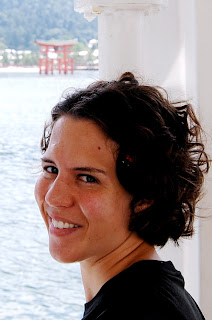The word for "castle" in Japanese is actually "jo", so of course Joe and I always have a good time introducing him to new Japanese comrades as "Hiroshima Joe", same as the castle. They never forget his name!
Introducing the real Hiroshima Joe...



Would the real Hiroshima Joe please stand up?

The other Hiroshima-jo up close. Can't compare, I know.
I swung by the castle the other day and finally took a tour of the museum inside. It is mildly interesting, at least more-so than other castles I've toured since many of the exhibits have English explanations. It focuses mainly on the history of the castle and displays some historic artifacts.
I liked that you could actually step out onto the open-air tower for a low view over the city — nothing too spectacular as this castle isn't on a mountaintop, but there was a very pleasant breeze.

Decorative windows in the castle tower.
The castle's nickname is Carp Castle. The reason for this is that the area where the castle was built was called Koi-no-ura (Koi Sea Shore) back then. "Koi" means carp in Japanese — hence, Carp Castle. And of course, Hiroshima's professional baseball team is now the Carp, too — with the same red uniforms and "C" logo as the Cincinnati Reds (and the bad luck to match, too!).
Interestingly, the construction of the castle also had something to do with the name of the city itself. When the castle was built, Hiroshima was not known as Hiroshima. The area was called "Gokamura", which means five villages in Japanese. It was decided that a more appropriate name was called for when construction of the castle began. The new name was formed by borrowing the character 広 (hiro, which means wide) from the name of Oeno Hiromoto, an ancestor of the Mori family, which ruled the area at that time. Then 島 (shima, which means island) was taken from Fukushima Motonaga, who guided the feudal lord Mori Terumoto to the site.
And so you see why Hiroshima's nickname is the Wide Island — hence the name of the Hiroshima JET webzine I edit, the Wide Island View.
There's also another tradition that states that Hiroshima's name originated from a wide island at the mouth of the Otagawa River that runs through the city.
One of the things I found interesting about the castle was the way it was constructed using the river in its defense. The banks of the islands on which the castle stood were built up higher than the opposite banks. In the event of an attack, the plan was to destroy the smaller banks, thus flooding the enemy camp and throwing them into confusion.

The guys on horseback would be blindsided by a sudden flood of water.
Personally, I don't think Hiroshima Castle is as pretty as a lot of other reconstructed castles. It's got less decorative ornamentation, looks older and seems to be not as well maintained. But maybe that's intentional to make it look more like the original?
Wikipedia tells me there used to be around 5,000 castles in Japan. Most of these wooden castles were built between 1467 and 1603, when Japan was going through it's "Warring States" period. Feudal lords built the castles as military defense in the areas they ruled.
Today, there are around 100 castles left and of those only about a dozen are originals (including Kochi Castle, which we visited last year.) Many were destroyed as relics of the past during the Meiji Period (in the late 1800s) after Japan opened itself to the West, and many more met their demise during World War II.
One of the reconstructed castles is Osaka Castle, which was just restored in 1997. To get to Nara, Joe and I had to take a bus to Osaka first, so we stopped for dinner and took a stroll through the castle grounds.
Rising from a 100-foot high stone block foundation, Osaka Castle is pretty impressive — in my opinion, anyway. Traditionalists may look over their noses at these "fake" castles, which they say are built just for the tourists, but whatever. I still thought it was very pretty, and the crouching golden tiger decorations were a nice touch.

We didn't have time to tour the museum inside since we were just pausing on our way to Nara, and from what I've read the exhibits aren't in English anyway, so it seems that we didn't miss much.
On our way home from Nara, we took a detour to Himeji Castle, which is considered the finest castle in Japan. I have wanted to see Himeji ever since seeing our first castle in Iwakuni, which displayed pictures of castles from all over Japan. Every time I pointed out a beautiful picture, it turned out to be the same castle — Himeji. Built in 1609, it is one of the few originals remaining, and it is the best preserved castle in Japan.

Himeji Castle
View of the inside.

A "heavily fortified" wooden door that closed off the area where the women lived.
Himeji had some interesting features, like hidden rooms in the attic and small holes where you could drop stones or boiling water onto attackers who tried to climb the walls. (Or perhaps just shoot them or wing a spear at them.)














































